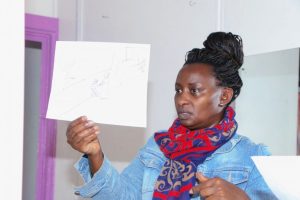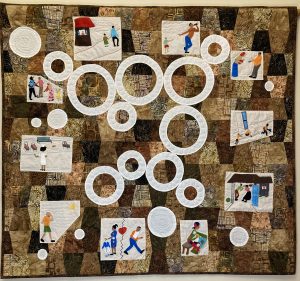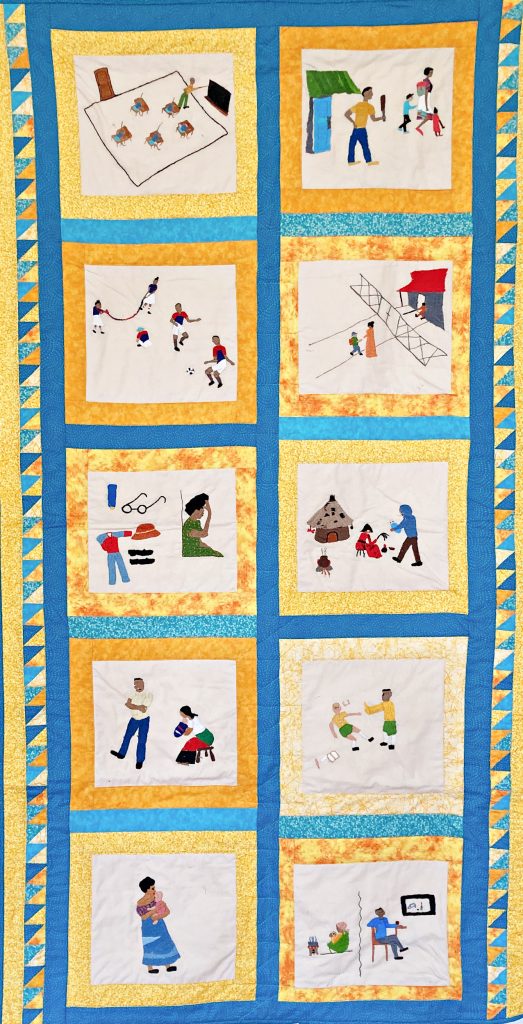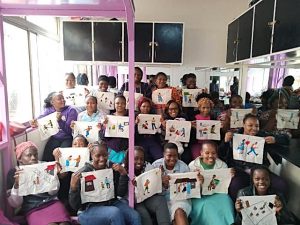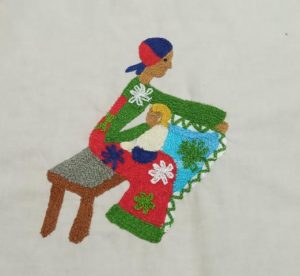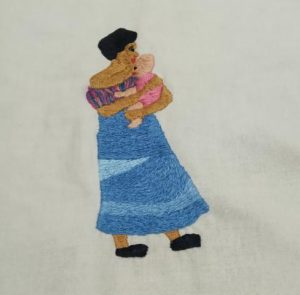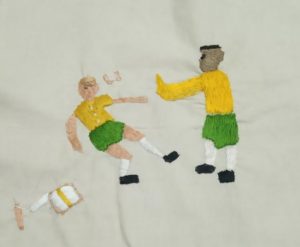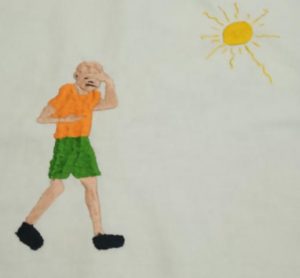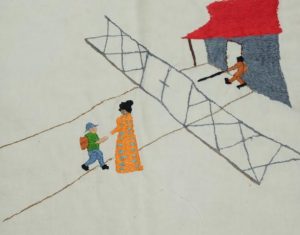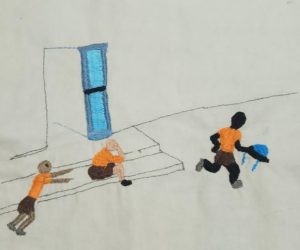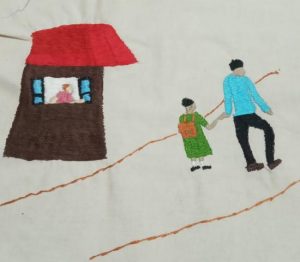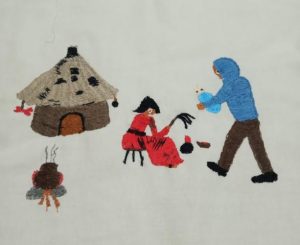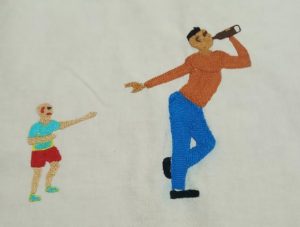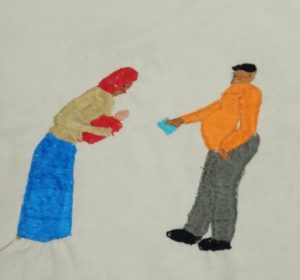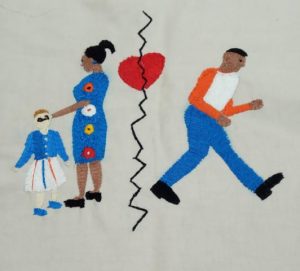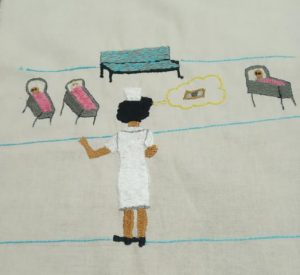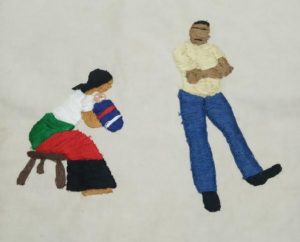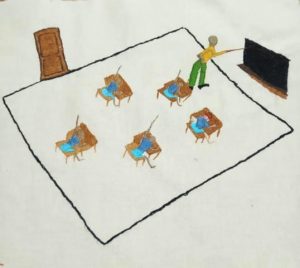The Kenyan Albinism Quilts
Background
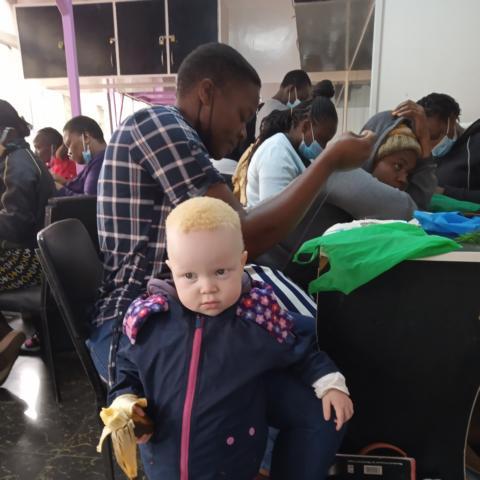
Living in the shadows: Children with albinism and their mothers face discrimination and threats to their safety and security, even in enlightened countries like Kenya.
A young mother hides her newborn our of shame and fear as she breastfeeds. Husbands abandon their wives when they first see the color of their child’s skin. Neighbors refer to children with albinism as “money” in reference to the imagined value of their body parts. Classmates steal sunscreen from students with albinism even though it protects them against cancer.
These are among the twenty poignant stories on these pages. All describe the challenge facing Kenyan children with albinism, a medical condition that exposes them to discrimination, violence, and superstition. Eighteen of the artists have children with albinism and they are forever looking over their shoulders, even in an enlightened country like Kenya.
The stories were embroidered in 2021 by twenty members of the Albinism Society of Kenya (ASK), the country’s leading advocate on albinism, with support from The Advocacy Project. They were assembled into two advocacy quilts by American quilters this spring.
These pages will go live on June 13, 2022, International Albinism Awareness Day. We hope they will empower the artists and help this misunderstood minority to enjoy better legal and medical protection.
ASK describes albinism as “a group of inherited conditions caused by a lack or deficiency in melanin, the photo-protective pigment that protects us from the sun’s harmful ultraviolet rays. This can result in physical characteristics like white or light blond hair, violet to blue eyes, very pale skin that is particularly sensitive to the sun.”
Precise figures are hard to come by, although the 2019 Census on Kenya put the number of Kenyans with albinism at 9,729 – one for every 4,890 Kenyans. The ratio in most northern countries is put at around one to 15,000 – 20,000.
Albinism in Africa has long been associated with superstition, prejudice and violence. Part of this is due to a bizarre belief that the body parts of people with albinism can ward off evil spirits and even protect building projects against disaster. As with child sacrifice, such superstitions are exploited by ruthless traffickers and witch doctors. (Those who seek a deeper explanation should review the blogs of Jamyel Jennifer, who worked as an AP Peace Fellow in 2011 with the Gideon Foundation in Uganda. The foundation was established by a father whose infant son was kidnapped, murdered and dismembered.)
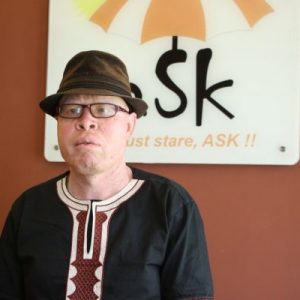
Daniel Sishia, Programs Manager at the Albinism Society of Kenya, coordinated the story-telling project for ASK.
The level of violence against people with albinism has fallen dramatically since 2009, when a report by the International Federation of Red Cross and Red Crescent Societies stated that a complete set of body parts from a person with albinism including “all four limbs, genitals, ears, tongue and nose” could bring in up to $75,000 on the black market.
But the threat from trafficking is still real. Based on 113 replies to a questionnaire from 63 countries, a 2021 report by the UN found that “As of April 2019, this particular misconception has caused 208 people to be murdered, and 585 to be attacked, across 28 African countries since 2006.”
Kenya has been at the forefront of African governments seeking to protect people with albinism and advocates were elated when the government included albinism in the 2019 census. The government also funds the National Albinism Sunscreen Support Program (NASSP) which provides free sunscreen and currently benefits around 4,000 people.
But as the stories on these pages show, the need for special protection – legal, medical and social – remains urgent even in a progressive country like Kenya.
The fear of trafficking remains deeply ingrained. Several artists hear their children described as “money,” which is presumed to refer to the imagined value of their body parts. Some of Everlyn Narotso’s neighbors even told her outright that her 12 year-old son Rodrick could be used as a “charm to boost business.” Yvonne Wanjiku is afraid to leave her son Prince, 5, when she goes to work in case he is trafficked. Three stories show children being abducted.
Even when they are not directly threatened, many of the artists feel stigmatized and isolated. Most of the artists are constantly looking over their shoulders and one block by Ruth, a mother of two children with albinism, shows Ruth hiding her baby as she breastfeeds out of shame and fear. Much of the stigma comes from immediate families. Of the 18 artist mothers no fewer than 12 were abandoned by their husbands. Almost all were shunned by their in-laws and several have been harassed by their former husbands.
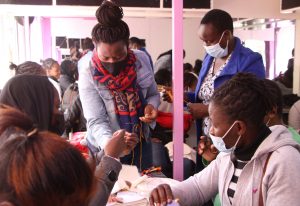 The isolation even extends to places of sanctuary. When she visited a hospital, Esther was asked by a nurse if she would like help in selling Hope, her 4 year-old daughter. Parents have confronted Esther at church and asked her if Hope’s albinism is contagious. It isn’t, but Esther had to lie that it is contagious to avoid further harassment.
The isolation even extends to places of sanctuary. When she visited a hospital, Esther was asked by a nurse if she would like help in selling Hope, her 4 year-old daughter. Parents have confronted Esther at church and asked her if Hope’s albinism is contagious. It isn’t, but Esther had to lie that it is contagious to avoid further harassment.
School is also a challenge. Esther gave one of Hope’s teachers sunscreen for Hope and asked the teacher to help her put it on, but Hope still came back home with sunburn. Liza Awor moved her son Rock, 8, to a private school in the hope that he would be better protected, but she still has to explain why his teachers refuse to interact with him outdoors.
The children themselves face harassment and bullying at school. Mercyline Charuma’s son Alvin, aged 6, is pushed around on the soccer field. Rodrick Narotso, 12, has his sunscreen stolen by his classmates. Carolyn Nyambura’s story shows a student with albinism who doesn’t raise his hand in class because he knows he will not get called by the teacher.
There are some striking exceptions to the overall sense of sadness, and acts of kindness. Julia Withera learned about albinism while studying as a beautician and has since become an enthusiastic advocate. She enjoys the company of the other mothers. Rachel Njoroge, a mother of three, volunteered to raise her brother’s son Kylan, who has albinism, and has been enriched by the experience.
Albinism has been on the UN’s human rights agenda since 2015, but legal protection on its own will not be enough to address the full range of threats depicted in these pages. The medical threat is particularly severe because the eyes and skin of people with albinism are so sensitive to the sun and can result in cancer. (The UN views albinism as a cause of disability and one recent UN report describes persons with albinism as “visually impaired.”) Poverty is also a major problem, because so many mothers are single and lost their jobs during the pandemic. This makes it harder for them to purchase sunscreen and headgear.
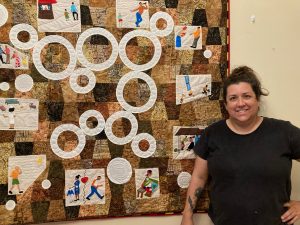
Christine Danler was deeply affected by the stories as she made the quilt. The white circles show that we are all connected as human beings.
This presents ASK with some clear advocacy goals and the organization is pressing the government to increase the subsidy for protective sunscreen. But a more important goal is to empower family-members, particularly mothers.
Making embroidered stories as a group, and sharing their fears with other mothers, was an important first step. Liz Awor says that whenever she felt stressed throughout this project she would revert to the embroidering to “immediately help her relax.”
The next stage of this program will address poverty and focus on income-generation. Several artists have opted into a composting project that will be led by Stella Makena (shown in the top photo) and supported by AP, as described in this recent bulletin. AP may also support a start-up to train mothers in producing bucket hats, and offer further embroidery training in Nairobi in July.
The embroidered stories have been assembled into two advocacy quilts by Christine Danler from North Carolina and Jane Cancilleri from Massachusetts. Christine tells us that she was deeply affected by the experience and explained that the distinctive white circles on her quilt show how we are all connected as human beings. We hope the quilts can help to advance ASK’s advocacy agenda in Kenya.
First Quilt
Second Quilt
Artists and Squares
Ruth Njeri
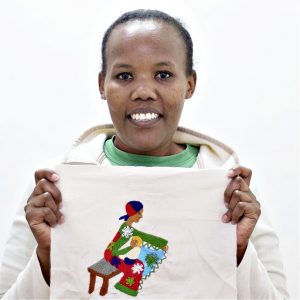 Ruth Njeri is a single mother of three with two children with albinism, a boy and a girl. Her firstborn is 17 years old and is in form four and her other child is 12 years old and is in class four.
Ruth Njeri is a single mother of three with two children with albinism, a boy and a girl. Her firstborn is 17 years old and is in form four and her other child is 12 years old and is in class four.
She has encountered many challenges raising children with albinism. She had not come across a child with albinism until she had her first child. Ruth always covered her child because he was different from the children around her and she was afraid of how the public would react. She was once advised to take her child to a pastor to pray for her child to acquire melanin. However, she later realized that that was impossible and learned to accept her child.
Her biggest challenge is accessing sunscreen for her two children with albinism. Sunscreen is very important for child with albinism because it prevents sunburns that can in turn lead to skin cancer. Ruth has learned to deal with the uninformed public who call her children with albinism ‘money’ by educating them. She earns a living from recycling fabrics and through tie-dyeing to transform them into wearable clothing materials. Ruth enjoys embroidery and appreciates the project because it has connected them with other mothers of children with albinism. She has also learnt new skills which she hopes to use to earn a living and to better plan her finances.
Ann Mutei
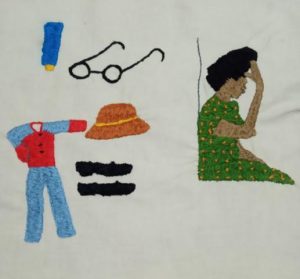
A mother is stressed thinking of all of the protective gear that must be bought for her child with albinism.
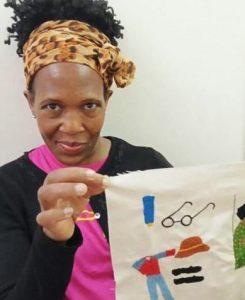 Ann Mutei is a single mother of a child with albinism. Her husband left her when she gave birth to her child. Ann depends on the odd jobs that she gets from time to time to survive and to provide for her child. Ann narrates her experience raising a child with albinism and the challenges that she encounters.
Ann Mutei is a single mother of a child with albinism. Her husband left her when she gave birth to her child. Ann depends on the odd jobs that she gets from time to time to survive and to provide for her child. Ann narrates her experience raising a child with albinism and the challenges that she encounters.
Ann’s biggest challenge is proving the essential items for her child such as protective wear and sunglasses, which are essential in protecting her child. She also adds that access to sunscreen is a challenge especially when the hospital runs out of the sunscreen that is supposed to be available for persons with albinism for free. She appreciates the impact of the project and how it has helped her acquire embroidery skills and get a stipend to take home at the end of the session.
Brenda Ateino
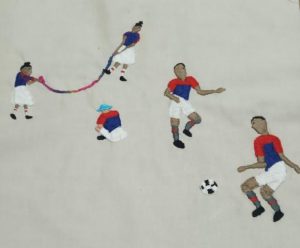
A child with albinism sits alone in a school playground as other children play around him. Many children with albinism are excluded by other students because they look different.
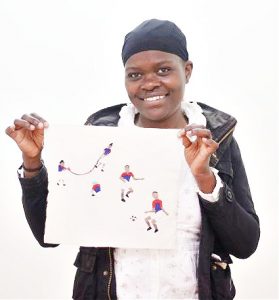 Brenda Atieno is a mother of two with one child with albinism. She is married, but not to the father of her first child with albinism. The biological father came to see her child but immediately left after seeing that the child had albinism. Brenda encountered rejection from the family of her now-husband. He was highly discouraged from marrying her because his family saw the union as introducing a curse to the family.
Brenda Atieno is a mother of two with one child with albinism. She is married, but not to the father of her first child with albinism. The biological father came to see her child but immediately left after seeing that the child had albinism. Brenda encountered rejection from the family of her now-husband. He was highly discouraged from marrying her because his family saw the union as introducing a curse to the family.
Before getting married, Brenda worked as a housekeeper with a low salary 1 week after giving birth, She was later employed as a teacher and that is how she has managed to raise her child. Brenda was first introduced to sunscreen by her neighbor who saw the pain her child experienced after being exposed to the sun. Her child used to cry and turn pink and Brenda didn’t understand the cause of her child’s pain. The neighbour explained the condition to her and advised her to use sunscreen. Brenda was constantly being told that she gave birth to a bad seed by her relatives and has encountered several cases of her child almost being trafficked at school. On one occasion there were men claiming that her child was worth a lot of money and another incident where a woman was claiming to give the child a school uniform. Both times, Brenda was fortunate to realize the danger of the situation and took precautionary measures. She hopes to use the skills that she learned through the project to open an online store and sell embroidery works.
Margaret Waringa
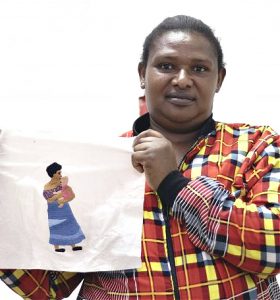 Margaret Waringa has three children, one, a 17 year old child with albinism named Evans. Her child was almost trafficked when he was young and has received threats from people who constantly refer to him as money. The father of her children left her when her child was born.
Margaret Waringa has three children, one, a 17 year old child with albinism named Evans. Her child was almost trafficked when he was young and has received threats from people who constantly refer to him as money. The father of her children left her when her child was born.
Margaret has previously worked as a liner to make ends meet and was advised to stop after she developed health complications. She is currently unemployed and depends on the odd jobs that she is offered from time to time. Margaret wants to urge all mothers to accept their children and not to hide them from society because of their albinism. She adds that children with albinism need extra care and emphasizes the importance of sunscreen for children with albinism.
Violet Inyaje
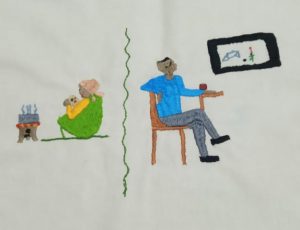
A mother and father are shown living two separate lives. The father carries on with his life without taking care of his child while the mother has to deal with the stress of having a child with albinism.
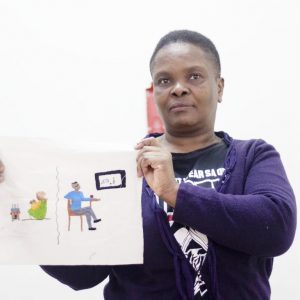 Violet Inyanje has four children, two of them children with albinism. She currently works as a housewife. Violet used to own a business but she unfortunately, had to close her business due to financial constraints.
Violet Inyanje has four children, two of them children with albinism. She currently works as a housewife. Violet used to own a business but she unfortunately, had to close her business due to financial constraints.
Violet faced several challenges after giving birth to her first child with albinism. She felt separated and isolated from others because her child had albinism and many people were scared of the child. Because of this stigma, Violet had to raise her child alone without the father’s help.
Rehema Owiti
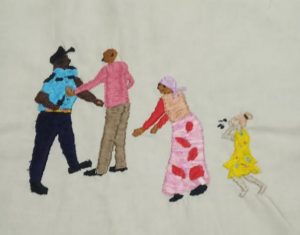
Children with albinism are not often welcomed in the community. In this block, a family of a child with albinism are bribing police so their child can be safe.
 Rehema Owiti is a single mother with three children with one child with albinism. The child with albinism is named Nathaniel and is 4 years old.
Rehema Owiti is a single mother with three children with one child with albinism. The child with albinism is named Nathaniel and is 4 years old.
Rehema used to sell fish but due to financial complications, had to quit. Rehema currently depends on the casual jobs that she gets from time to time for survival. This is difficult, because of the many financial hurdles that mothers of children with albinism have.
Mercyline Charuma
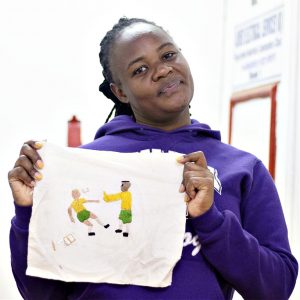 Mercyline Charuma is a mother of one child with albinism. Her son, named Alvin is in grade three and is six years old. Apart from comments like “this child is money”, she was lucky to not experience major challenges when she gave birth to her son. Mercyline is very fortunate that her son was accepted by her family and was able to rely on them for support.
Mercyline Charuma is a mother of one child with albinism. Her son, named Alvin is in grade three and is six years old. Apart from comments like “this child is money”, she was lucky to not experience major challenges when she gave birth to her son. Mercyline is very fortunate that her son was accepted by her family and was able to rely on them for support.
Mercyline is currently working at a small businesses in Nairobi and enjoys the embroidery sessions because she gets to interact with and support other mothers of children with albinism. She wants to encourage parents to source sunscreen for their children and ensure that they apply sunscreen often to avoid sunburns.
Fridah Mate
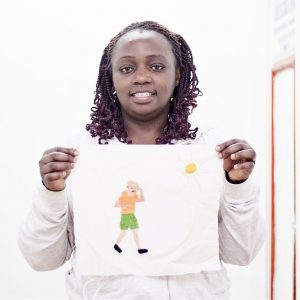 Fridah Mate is a guardian to Jackline Kagweria, a child with albinism. Jackline is an orphan. Her mother passed away from depression after her husband, the father of Jackline, abandoned Jackline and their mother. Jackline’s father also died later when she was a child. Jackline is 18 years old now and is currently in high school form four preparing to do her final exams.
Fridah Mate is a guardian to Jackline Kagweria, a child with albinism. Jackline is an orphan. Her mother passed away from depression after her husband, the father of Jackline, abandoned Jackline and their mother. Jackline’s father also died later when she was a child. Jackline is 18 years old now and is currently in high school form four preparing to do her final exams.
Fridah is a businesswoman and currently sells clothes to earn her livelihood. The biggest challenge in raising a child with albinism was discrimination because people in the village would assume that if they touched a person with albinism they’d also become a person with albinism. She had to counsel Jackline as a young lady to learn how to handle her albinism. She is happy to be part of the project because she was able to gain skills that she can now use to get an income.
Winnie Akoth
 Winnie Akoth is a mother of two with one child with albinism who is 6 years old. Winnie and her husband separated for 2 years but they later got back together. The main reason for the separation was due to her mother-in-law. Winnie’s mother-in-law would tell the son that the child was not his and she would advise her son to leave her.
Winnie Akoth is a mother of two with one child with albinism who is 6 years old. Winnie and her husband separated for 2 years but they later got back together. The main reason for the separation was due to her mother-in-law. Winnie’s mother-in-law would tell the son that the child was not his and she would advise her son to leave her.
Winnie decided to leave the marriage after she overheard her mother-in-law attempting to convince her husband to abandon her and her child. They later reconciled with her husband and they are now living together. Winnie is currently unemployed and depends mostly on her husband to provide financially for the family. When she can, she does laundry for people and gets paid depending on the load of laundry. Winnie hopes to get a job so that she can also contribute financially.
Fridah Marauni
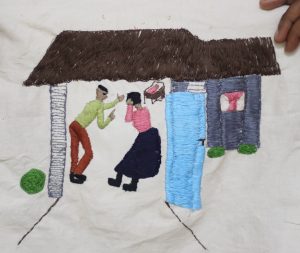
A man and woman argue after their baby has been born with albinism. Many men accuse their wives of infidelity when a child is born with albinism.
 Fridah Marauni is a mother of two with one child with albinism named Jamile. Jamile is two years old. When she gave birth to her son, she was not accepted by the family of her husband. Fridah is currently a stay-at-home mom. She used to own a grocery kiosk but later closed due to financial reasons.
Fridah Marauni is a mother of two with one child with albinism named Jamile. Jamile is two years old. When she gave birth to her son, she was not accepted by the family of her husband. Fridah is currently a stay-at-home mom. She used to own a grocery kiosk but later closed due to financial reasons.
Fridah is happy to have mingled with other mothers of children with albinism because she used to think that she was the only one with a child with albinism. There are still a few people who have not accepted her child and once in a while, she gets comments from people who tell her to sell her child in Tanzania. Fridah’s main challenge is access to sunscreen and she fears that now that her son is old enough to go outside he might get sunburns.
Everlyn Narotso
 Everlyn Narotso is a single mother of one child with albinism, 12 year-old Rodrick. She holds a certificate in hotel supervision and a diploma in procurement. Everlyn is currently working as a caterer in a school where she gets paid per day.
Everlyn Narotso is a single mother of one child with albinism, 12 year-old Rodrick. She holds a certificate in hotel supervision and a diploma in procurement. Everlyn is currently working as a caterer in a school where she gets paid per day.
Everlyn and her husband separated after she gave birth to Rodrick. Her husband’s family accused her of infidelity and organized for him to marry another wife. Her child has been openly discriminated against by the father’s family and the public. He gets called “money” in public and some even say that his body parts can be used as a charm to boost one’s business. Her son’s skin is very sensitive and he has suffered from many sunburns because she is not always around to protect him. Everlyn has enjoyed the embroidery project because it has really empowered her and has brought mothers of children with albinism together.
Rebecca Waithera
 Rebecca Waithera is a mother of one child and works as a beauty teacher training a group of students with albinism. She considers them a special group because they are very talented. However, Rebecca is particularly keen on how she trains them because of their eyesight. She mentors them and teaches them about skincare and how to take care of their skin.
Rebecca Waithera is a mother of one child and works as a beauty teacher training a group of students with albinism. She considers them a special group because they are very talented. However, Rebecca is particularly keen on how she trains them because of their eyesight. She mentors them and teaches them about skincare and how to take care of their skin.
Rebecca is passionate about teaching and was happy to have been part of the embroidery project because it has expanded her creativity. Her message to the public about children with albinism is that they should not discriminate against them, but instead include them in society.
Liz Awor
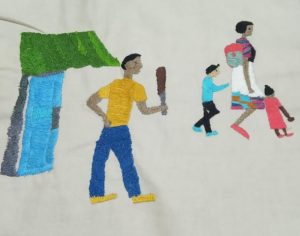
A husband kicks out his wife because she gave birth to a child with albinism. The mother is walking away with her children.
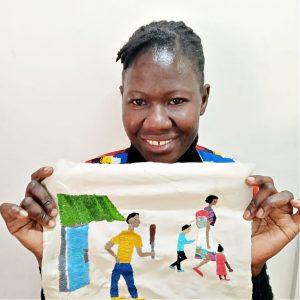 Liz Awor is a single mother of two children, one with albinism named Rick. Rick is 8 years old and her other child is 11. Liz and her husband separated after she gave birth to her child with albinism. Her husband’s family accused her of infidelity, which created a rift between them.
Liz Awor is a single mother of two children, one with albinism named Rick. Rick is 8 years old and her other child is 11. Liz and her husband separated after she gave birth to her child with albinism. Her husband’s family accused her of infidelity, which created a rift between them.
Liz was working as a teacher in a technical college and lost her job when the pandemic struck. She currently owns a small business where she imports rice and sells it locally. Due to fear of her child being neglected by the teachers in school, she took him to a private school which put a strain on her finances. Liz’s main challenge is having to constantly explain to her 8-year-old why the teachers are not engaging him in outdoor activities. The teachers at school often fear engaging him in activities because they feel like he won’t keep up. She also fears leaving him alone because of some people believe the myth that her child’s body parts are worth a lot of money.
Liz mentions that whenever she was stressed throughout this project, she’d start embroidering and it would immediately help her relax. Her main source of comfort and joy is seeing her son top his class. She wishes to inform the public that albinism is a genetic condition and is not a result of infidelity.
Rachael Njoroge
 Rachael Njoroge is a single mother of three. She is a guardian to her brother’s child with albinism named Kylan. She decided to help her brother by taking in her nephew. Raising Kylan has taught her a lot about albinism in terms of protective wear and sun protection. She is currently unemployed and is hoping to start a business selling second-hand clothes. Rachael had learned a bit of embroidery in school and never imagined she’d practice it again. She is glad to have been part of the project because she got to exercise the skills she learnt in school.
Rachael Njoroge is a single mother of three. She is a guardian to her brother’s child with albinism named Kylan. She decided to help her brother by taking in her nephew. Raising Kylan has taught her a lot about albinism in terms of protective wear and sun protection. She is currently unemployed and is hoping to start a business selling second-hand clothes. Rachael had learned a bit of embroidery in school and never imagined she’d practice it again. She is glad to have been part of the project because she got to exercise the skills she learnt in school.
RoseAnn Wairimu
 RoseAnn Wairimu is a mother of two children who are 16 and 13 years old. She has one child with albinism who is in high school. She is married, but not to the father of her child with albinism.
RoseAnn Wairimu is a mother of two children who are 16 and 13 years old. She has one child with albinism who is in high school. She is married, but not to the father of her child with albinism.
Rose was employed for 6 years but later tried different businesses such as selling second-hand clothes and pastries. She is currently working in a business but still depends on her husband for support. When she gave birth to her child with albinism the people around her had mixed feelings. Some people were saying that the child will eventually acquire melanin if she is exposed to the sun for long. She, however, knew about the condition because she had taken a keen interest in genetics, a topic she studied in high school.
Every time Rose walks with her child some people call her child “money”, a common myth that the public has about persons with albinism. She found out about sunscreen when her child was 6 years after her baby had experienced a bad sunburn. She states that the main challenge in raising a child with albinism is preventing your child from the harsh sun rays. Rose states that the sun not only affects the skin but the eyes also. It was her first-time learning embroidery and Rose was happy because it keeps her busy and she can potentially use the skill to start a business.
Judy Mwikali
 Judy Mwikali is a single mother of one, Paul, a three-year-old with albinism. She is currently unemployed and depends on odd jobs to earn her living.
Judy Mwikali is a single mother of one, Paul, a three-year-old with albinism. She is currently unemployed and depends on odd jobs to earn her living.
Judy’s husband accused her of infidelity and they separated soon after she gave birth to Paul. She also had a hard time accepting her child and had to go through counseling before accepting him. Judy would like to urge the public to not discriminate against children with disabilities in general because they are sensitive and they are going through a lot already.
Julia Waithera
 Julia Waithera is a mother of three and is currently a beauty student. She studies with young persons with albinism and interacts with them on a daily-basis. She got to learn about albinism when she started studying beauty.
Julia Waithera is a mother of three and is currently a beauty student. She studies with young persons with albinism and interacts with them on a daily-basis. She got to learn about albinism when she started studying beauty.
Julia was interested to be part of the group because of her growing interest in albinism. She is particularly grateful to have interacted with mothers of children with albinism because she got to understand their struggle. Julia believes she can spread the word out there on how to demystify myths around persons with albinism. She also mentions that the project has helped her to gain an additional skill and would want to advance her embroidery skills. Julia wants to encourage the public to appreciate children with albinism and not refer to them as a curse.
Esther Wambui
 Esther Wambui is a mother of three with one child with albinism, Hope, who is 4 years old. She is currently unemployed and depends on odd jobs for survival.
Esther Wambui is a mother of three with one child with albinism, Hope, who is 4 years old. She is currently unemployed and depends on odd jobs for survival.
Esther encountered challenges immediately after giving birth to her child with albinism. A nurse at the hospital was interested in her case and asked Ester if she could find someone who would buy Esther’s child. At the hospital, she noticed that her fellow mothers did not want to interact with her because they didn’t understand her baby’s condition. Esther and her husband separated and he chased her and her children away after accusing her of infidelity. They later got back together but everything changed her husband was not the same person she knew. He neglects his responsibilities and has left all the family responsibilities to her.
Esther experienced discrimination even at her church. Parents did not want their children to interact with her child. One parent asked her if the condition is contagious and she had to lie that it is contagious to avoid further interaction. She also had issues with the school because her child used to come home with sunburns. This happened despite Esther giving the teacher sunscreen lotion and advising her to help apply it before going outside to play. Esther is grateful to have been part of the project because it exposed her to new opportunities and she got to interact and share ideas with other mothers.
Yvonne Wanjiku
 Yvonne Wanjiku is a single mother of one child with albinism named Prince who is 5 years old. Yvonne owns a dress-making business. Yvonne and her husband separated when she was 2 months pregnant. She tried reaching out to him after she gave birth but he blocked them. She took her baby to see his father but the father chased them away and failed to offer child support.
Yvonne Wanjiku is a single mother of one child with albinism named Prince who is 5 years old. Yvonne owns a dress-making business. Yvonne and her husband separated when she was 2 months pregnant. She tried reaching out to him after she gave birth but he blocked them. She took her baby to see his father but the father chased them away and failed to offer child support.
Yvonne’s biggest challenge is leaving her child with someone when she is going to work. She fears that her child might be stolen and trafficked. The other challenge is diet. She mentions that the skin of a person with albinism is very sensitive to the diet. She ensures that he gets the right food which ensures her son’s skin is well nourished. Her son has also suffered from sunburns and that experience has taught her not to let her son be exposed to the sun for long. She ensures that he applies sunscreen before going out. She is glad to have been part of the embroidery project because she got to advance her skills and hopes to use the skill in her dressmaking business. Additionally, she hopes to get enough finances to expand her dressmaking business.
Caroline Nyambura
 Caroline Nyambura is the communications and advocacy officer at Albinism Society of Kenya, a civil society organization that champions for the rights of persons with albinism. She is passionate about human rights and social inclusion for the marginalized.
Caroline Nyambura is the communications and advocacy officer at Albinism Society of Kenya, a civil society organization that champions for the rights of persons with albinism. She is passionate about human rights and social inclusion for the marginalized.
Working at the Albinism Society of Kenya, she has observed how society treats persons with albinism and feels there is a need to lend a voice. Through her advocacy works, she hopes to dehumanize labels that are socially embedded and influence change.
Caroline is happy to have been part of the Advocacy Project quilt because she got to learn embroidery and interact with mothers of children with albinism. She enjoyed the sessions and deems them therapeutic. Every time she was tense or stressed she’d calm herself by embroidering. She hopes to use her newfound skill and interest to continue with the message of advocacy.

